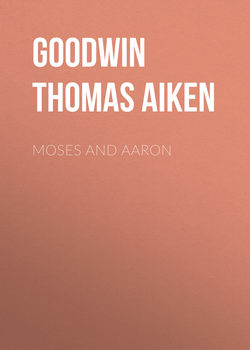Читать книгу Moses and Aaron - Goodwin Thomas Aiken - Страница 8
THE FIRST BOOK
TREATETH OF PERSONS
CHAP. VII.
Of their Title Rabbi
ОглавлениеAbout the time of our Saviour Christ his Nativity, Titles began to be multiplied; and amongst the rest, these of Rab, Ribbi, Rabbi, and Rabban, were in especial use: they all are derived from רבב Rabab, signifying, multiplicatus fuit, and they sound as much as πολυμαθέστατος, that is, a Master, or Doctor eminently gifted with variety of Knowledge. Concerning these titles, they write thus,73 that Rabbi is a more excellent title than Rab, and Rabban more excellent then Rabbi; and the simple name without any title, as Haggai, Zachary, Malachy, was more excellent than Rabban. About this time they used a set form of Discipline in their Schools. The Scholar was termed תלמיד, Talmid, a Disciple, in respect of his Learning; קטן Katan, a Junior, in respect of his minority; בחור Bachur, that is, one chosen, or elected in respect of his election, or cooptation, into the number of Disciples; After he had proved a good Proficient, and was thought worthy of some degree, then was he by imposition of hands made a Graduate חבר Chaber, a Companion to a Rabbi. This imposition of hands, they termed סמכה, vel סמיכות, Semicah, or Semicuth, which Ceremony they observed in imitation of Moses towards Joshua. The Lord said unto Moses, Take thou Joshua the son of Nun, in whom is the Spirit, and put thine hand upon him, Numb. 27. 18. At which time he that imposed hands on him, used this form of words,74 I associate thee, and be thou associated. After this when he was worthy to teach others, then was he called Rabbi, and whereas in his minority, his own name being suppressed, he was called onely by his Fathers name, the son of N. When he was made Graduate by imposition of hands, then was he called by his own name, N. the son of N. And afterward when he was thought worthy to teach, then was the Title Rabbi prefixed, after this manner; Rabbi N. the son of N. For example, Maimonides; at first was termed onely Ben Maimon, the son of Maimon; after his degree, then was he called by his own name, added to his fathers, Moses Ben Maimon, Moses the son of Maimon: at last being licenced to teach, then was he called רמבם Rambam, which abbreviature consisting of Capital Letters, signifeth, Rabbi Moses Ben Maimon, Rabbi Moses the son of Maimon. So Rabbi Levi, the son of Gersom, in his minority was called the son of Gersom, afterward Levi the son of Gersom at last, רלבג Ralbag, Rabbi Levi the son of Gersom. This distinction of Scholars, Companions, & Rabbies, appeareth by that speech of an ancient Rabbi, saying,75 I learned much of my Rabbies, or Masters, more of my companions, most of all of my Scholars. That every Rabbi had Disciples, and that his own Disciples, and other well-wishers stiled him by the name of Rabbi, in the dayes of our Saviour, needeth no proof. Judas came to Christ and said, God save thee Rabbi, Mat. 26. 49. In like manner Johns Disciples came and saluted John by the name of Rabbi, John 3. 26. and Christ by the name of Rabbi, John 1. 38. But whether there was such a formal imposition of hands then in use, I much doubt. The manner of their meetings, when Disputations were had in their Synagogues, or other Schools, was thus.76 The chief Rabbies sate in reserved Chairs; these are those chief seats of the Synagogues, which the Scribes and Pharises so affected, Mat. 23. 6. Their Companions sate upon Benches or lower Forms; their Scholars on the ground at the feet of their Teachers. Saint Paul was brought up at the feet of Gamaliel, Act. 22. 2. And Mary sate at Jesus feet, and heard his word, Luk. 10. 39. The positure of their body differed according to their degrees. The Rabbi is described77 to be יושב Joscheb, one that sitteth: the Companion, מוטת Muteth, the word signifieth a kind of leaning upon a bed or bench, ones head lying in the others bosome, in manner of the ancient sitting at table; and it was a deportment of the body, inferiour to that of sitting: The Scholar was termed78 מתאבק Mithabek, one that doth lie along in the dust, and this was a token of the Scholars humility, thus humbling and subjecting himself even to the feet of his Masters: This same custom it is thought,79 Saint Paul laboured to bring into the Christian Church, 1 Cor. 14. Their Scholars were not all of equal capacity, whence they said,80 some had conditionem spongiæ, others clepsydræ, others sacci fæcinacei, and others cribri. Some resembled the Sponge, and suck’d in all that they heard without judgment; others the Hour-Glass, they took in at one ear, and let out at the other; others the Winesack, through which Wine is so drained from the dregs, that only the dregs remain behind: Lastly, others the Rying-sieve, which in winnowing lets out the courser seed, and keepeth in the corn.
73
Aruch in voce אביי
74
אני סומך אותך תהיה סמוך Id est Scaligero interprete: Ego tibi impono manum & manus tibi imposita esto. Trihær. c. 5. p. 264. vide etiam Cunæum de Rep. Heb. cap. 12.
75
Vide P. Fagium in Scholiis suis ad cap. 4. Pirke Aboth.
76
Philo Jud. Quod omnis probus, p. 679.
77
Scaliger in Trihæres. cap. 5. Ex. c. 1. Beracoth.
78
Pirke Aboth. cap. 4.
79
Ambros. 1 Cor. 14.
80
Pirke Aboth. cap. 5.
